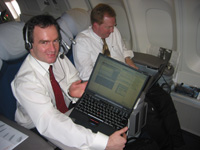The Future of Inflight Technology
 This year Lufthansa became the first airline in the world to provide powerful, high-speed broadband access during a scheduled flight.
This year Lufthansa became the first airline in the world to provide powerful, high-speed broadband access during a scheduled flight.
The Boeing 747-400 jet equipped with a broadband network is esteemed to be the model for commercial airline travel in the future.
Cisco
was selected by Lufthansa to supply the onboard infrastructure. In addition, Lufthansa looked to Boeing subsidiary, Connexion by Boeing
, to provide the data services between the plane and the ground, which can achieve speeds of 3 Mbps downstream and 128 Kbps upstream
For the new wireless broadband-enabled jets, Cisco provided the technology for the onboard network, equipping planes with both cable and wireless LANs. Each plane offers Wi-Fi (IEEE 802.11) compliant wireless connectivity in every cabin and an Ethernet connector in every seat.
The FlyNet portal provides a full range of up-to-date information, including financial, travel and lifestyle news, as well as Miles&More, product and service information from Lufthansa and updates on major news from the world of politics, business, sport and culture. Lufthansa
Passengers can use their personal laptops (and ones provided by the airline) to gain high-speed connections to the Internet, including full access to their personal or business email accounts and files.
During the flight, passengers can attach files to their outgoing emails or open attachments from incoming emails, get the latest news, look up information about their destination or shop online.
Wolfgang Mayrhuber, Deputy Chairman of Deutsche Lufthansa AG commented: “The very idea of FlyNet was exciting, but what really inspired me was the enthusiasm, the professionalism and the stamina of our team during its implementation. Innovation with the customer in mind has resulted in today`s world premiere.”
ADVERTISEMENT
Toby Burton, the Vice President for Cisco’s Internet Business Solutions Group in Europe, travelled onboard the inaugural Lufthansa B747-400 flying between Frankfurt and Washington and sent an email during the flight saying:
“5 hours into the flight, and having just handed over from the European to the US satellite, the 3MB downlink and 128kb uplink is resilient, even travelling at 600 miles per hour. The Lufthansa CEO, Wolfgang Mayrhuber, has spoken over Cisco softphone to Cisco EMEA President Rob Lloyd in Sweden, and was so impressed with the sound quality he immediately wanted to call his Chairman in South Africa.
“The Connection from Boeing CEO is busy explaining that although some executives may not want “always-on” connectivity, it in fact creates more quality family time because you can finish your business whilst airborne. This has the feel of a historic event, and even the stewardesses are joining in. One of them has discovered a particularly good gaming site and judging by the noises from the galley, we won`t get afternoon tea anytime soon”
Throughout the three-month demonstration the service is free-of-charge to passengers throughout the airplane, which flies daily between Frankfurt and Washington-Dulles International Airport as flights LH 418 (westbound) and LH 419 (eastbound).
If the trial is successful, Connexion intends to equip around 80 long-range B747-400 and Airbus A330/A340 aircraft by mid-2004. Internet access during scheduled operations is expected to cost between 30 and 35 euros per flight leg. In addition, passengers will be able to redeem Miles&More bonus miles to surf the Internet.
Jon Hindle, Strategic
Technology Manager Worldwide, Cisco Systems told Internet Travel News that he expects this service to be more successful than the in-flight telephone services: “It will certainly be a lot more cost effective and therefore a more popular service than in-flight telephone services”
He anticipates the service to be popular among both business and leisure passengers: “A lot of leisure travellers will probably travel with wireless-enabled PDAs, so in terms of fun and entertainment, I think it will be very popular - especially to email friends during a long flight. Clearly though in terms of productivity, it is the business traveller who will see the greatest benefit”. He added. “I think we’ll all be taking this type of connectivity for granted - rather like we do the flight map now!”
Since service demonstration with Lufthansa began in January 2003, British Airways have announced plans to begin demonstrations in mid-February. Japan Airlines and Scandinavian Airlines System (SAS) also have announced plans to equip longer-range jetliners in their fleets beginning in 2004.
Passenger connectivity has been available for a number of years; however, until recently, was limited to the under-performing telephony systems offered onboard. The proliferation of email and internet over the past decade combined with rapid developments in technology has led a number of companies into investing in these services for the onboard passenger market.
The number of players in the market and the wide range of technical solutions available have given rise to a high degree of confusion and uncertainty among the decision-makers in the market. There is a clear requirement for top-level knowledge in the market, with the situation being compounded by a high level of jargon and the difficulty of distinguishing between what are merely concepts and what can realistically be achieved.
The Inflight Management Development Centre (IMDC) has recently released a comprehensive review of the current market for inflight communication products and provides clarity in a currently complex and evolving market. For more information on this report, visit the IMDC website - www.inflightmanagement.com
.
——-

